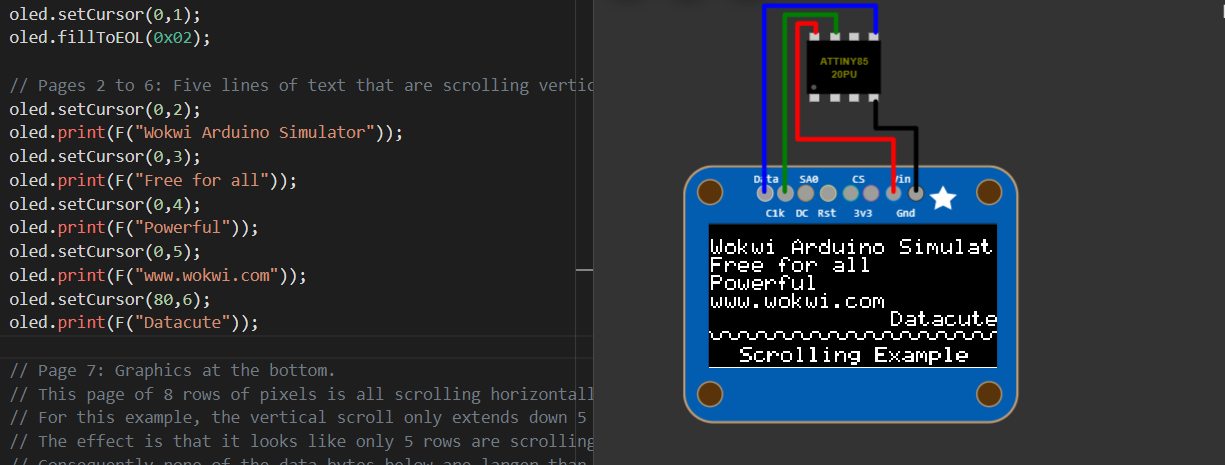Tiny4kOLED is a tiny Library for ATTiny85. It is simulated using Wokwi Arduino simulator
Tiny4kOLED
This is a library for an ATTiny85 to use an I2C SSD1306 OLED. It supports double buffering on 128x32 pixel OLED.
The SSD1306 has enough RAM to support a 128 by the 64-pixel display, and most SSD1306 controlled OLEDs are 128 by 64 pixels. However, there are also other display sizes available. With a 128 by the 32-pixel display, only half of the SSD1306's RAM is used, and the other half can be used as a frame buffer. This results in being able to have a slow ATTiny85 gradually update the display, then switch it into view when it is ready. Screens of other resolutions are supported by this library but only support double buffering if they are 32 pixels in height.
Author: Stephen Denne
Maintainer: Stephen Denne
Wokwi Arduino Simulator - SSD1306 display using Tiny4kOLED
/*
* Tiny4kOLED - Drivers for SSD1306 controlled dot matrix OLED/PLED 128x32 displays
*
* Based on ssd1306xled, re-written and extended by Stephen Denne
* from 2017-04-25 at https://github.com/datacute/Tiny4kOLED
*
* This example shows how the scrolling features work.
* When scrolling, the double buffering of screens cannot be used.
*
*/
// Choose your I2C implementation before including Tiny4kOLED.h
// The default is selected is Wire.h
// To use the Wire library:
//#include <Wire.h>
// To use the Adafruit's TinyWireM library:
#include <TinyWireM.h>
// To use the TinyI2C library from https://github.com/technoblogy/tiny-i2c
//#include <TinyI2CMaster.h>
// The blue OLED screen requires a long initialization on power on.
// The code to wait for it to be ready uses 20 bytes of program storage space
// If you are using a white OLED, this can be reclaimed by uncommenting
// the following line (before including Tiny4kOLED.h):
//#define TINY4KOLED_QUICK_BEGIN
#include <Tiny4kOLED.h>
void setup() {
oled.begin();
// Two rotations are supported,
// The begin() method sets the rotation to 1.
//oled.setRotation(0);
// Some newer devices do not contain an external current reference.
// Older devices may also support using the internal curret reference,
// which provides more consistent brightness across devices.
// The internal current reference can be configured as either low current, or high current.
// Using true as the parameter value choses the high current internal current reference,
// resulting in a brighter display, and a more effective contrast setting.
//oled.setInternalIref(true);
// Two fonts are supplied with this library, FONT8X16 and FONT6X8
// Other fonts are available from the TinyOLED-Fonts library
oled.setFont(FONT6X8);
// To clear all the memory, clear both rendering frames:
oled.clear();
oled.switchRenderFrame();
oled.clear();
oled.switchRenderFrame();
// The SSD1306 refers to 8 rows of pixels as a 'page'
// Page 0: One line of text at the top that is not scrolling
oled.setCursor(13,0); // 13 pixels to center the following text
oled.print(F("Scrolling Example")); // 17 characters x 6 pixels = 102 pixels
// Page 1: One lines of graphics
// For this example, the scrolled area is set up below to start after 11 rows.
// The top three rows of pixels in this page are not scrolling
// The bottom five rows of pixels are scrolling vertically
oled.setCursor(0,1);
oled.fillToEOL(0x02);
// Pages 2 to 6: Five lines of text that are scrolling vertically
oled.setCursor(0,2);
oled.print(F("Wokwi Arduino Simulator"));
oled.setCursor(0,3);
oled.print(F("Free for all"));
oled.setCursor(0,4);
oled.print(F("Powerful"));
oled.setCursor(0,5);
oled.print(F("www.wokwi.com"));
oled.setCursor(80,6);
oled.print(F("Datacute"));
// Page 7: Graphics at the bottom.
// This page of 8 rows of pixels is all scrolling horizontally
// For this example, the vertical scroll only extends down 5 rows into this page.
// The effect is that it looks like only 5 rows are scrolling horizontally.
// Consequently none of the data bytes below are larger than 0x1F
oled.setCursor(0,7);
oled.startData();
for (uint8_t i = 0; i < 16; i++) {
oled.sendData(0x02);
oled.sendData(0x02);
oled.sendData(0x02);
oled.sendData(0x0C);
oled.sendData(0x10);
oled.sendData(0x10);
oled.sendData(0x10);
oled.sendData(0x0C);
}
oled.endData();
// Scroll the bottom graphics on page 7
// 'interval' is how quickly it scrolls.
// 'offset' determines how far to scroll vertically for each horizontal movement
// startPage = 7, interval = 1, endPage = 7, offset = 1
oled.scrollLeftOffset(7,1,7,1);
// 11 rows in the top fixed (non-scrolling) area
// Vertically scroll 50 rows
// The remaining 3 rows are not included in the scroll, and are never visible.
oled.setVerticalScrollArea(11, 50);
oled.activateScroll();
oled.on();
}
void loop() {
// The scrolling happens automatically, and is performed by rearranging the RAM contents.
}
wokwi Arduino simulator and Tiny4kOLED
Visit https://wokwi.com for a powerful, state of the art Arduino simulator which is Free.





